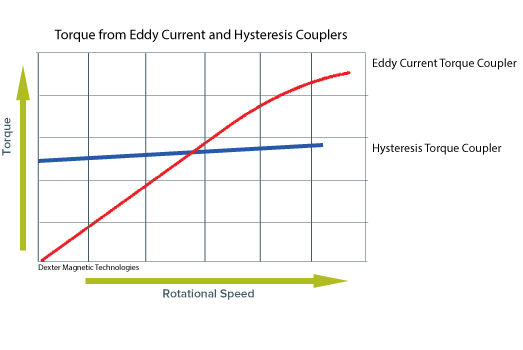Can coupling be used without a pressure barrier?
YES. The pressure barrier is only required if a pressure differential is expected between the two components or if the areas must be sealed
What is the torque / speed behavior for hysteresis and eddy current couplings?
Torque_EddyCurrent_Hysteresis_Couplers_GraphEddy current devices have a straight-line torque-speed characteristic, with the torque increasing linearly with the speed by virtue of the fact that the induced currents vary in magnitude with the speed of the rotating field. The eddy current torque coupling converts energy into heat in the conductive device. If the heat is not dissipated, it will increase the temperature of the conductive device resulting in non-linearity (see accompanying torque curves). In hysteresis drag devices, theoretically, the work done per revolution is constant and independent of time resulting in the torque being constant vs rotational speed. If the hysteresis component is conductive, it will also generate eddy current torque. As shown in the accompanying graph, the eddy current torque is proportional to rotational speed.

Is there a speed limit to these couplings?
The maximum speed of a coupling is very difficult to quantify. This depends on the design and application. Mechanically, the system can be designed and manufactured to handle virtually any speed (balancing and banding). Eddy currents induced in conductive media are typically the limiting factor in any magnetic coupling. These eddy currents lead to reduced force transmission and heating that may rival the efficiency of induction heaters in very high velocity applications.
Are there size limitations for these devices?
Virtually any size and shape can be produced. Torque couplings ranging from the mNm range to the kNm range have been designed and manufactured. Linear couplings from the mN to the kN range have also been designed and manufactured.
Do magnetic couplings self support or float?
Magnetics is a tricky topic that lends itself to ideas of levitation. Unfortunately, magnetic fields are never perfectly balanced and will always cause assemblies to shift to the lowest energy state. Consequently, all magnetic couplings require full mechanical support through radial and thrust bearings.
What happens if I exceed the force/torque rating of my coupling?
Luckily, due to the non-contact nature of these devices, they are inherently tolerant of overloading. For synchronous devices (Class I) an overload leads to a ratcheting effect as like poles repel one another. If the vibration does not cause damage to the system, the device will either recouple (torque couplings) or can be reset (linear couplings) once the load is returned to normal. For eddy current devices (Class II), permanent damage may occur as a result of eddy current heating. The amount of damage and heating is proportional to the amount of time the overload is active. For short durations, the system will simply recouple.

